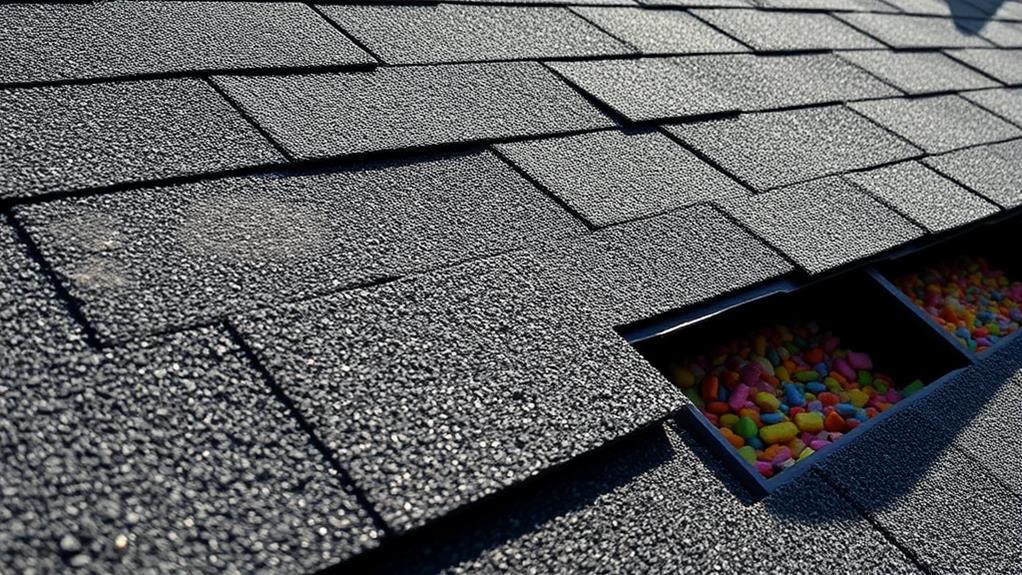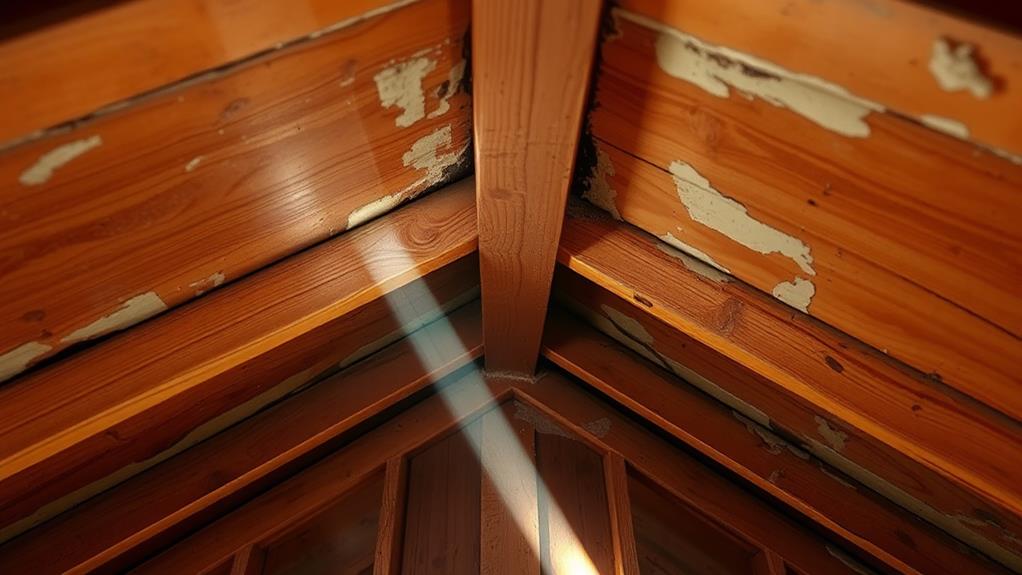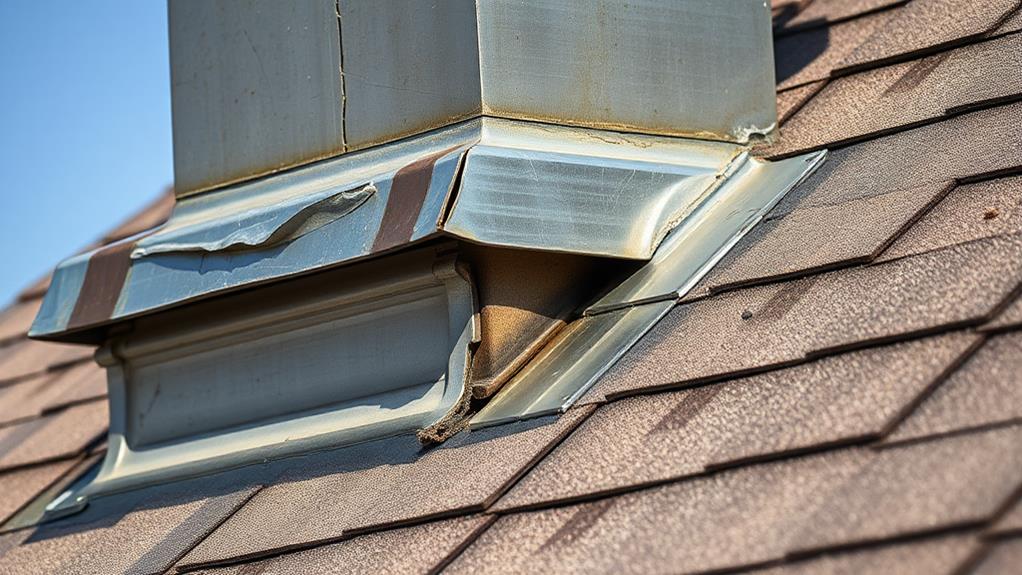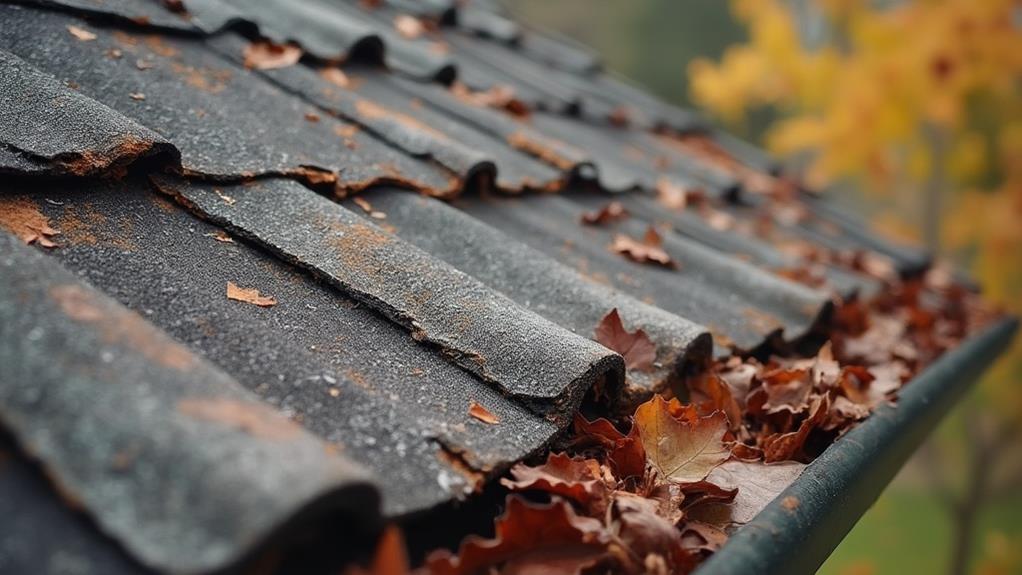The top 5 signs of hidden storm damage on your roof include excessive granule loss, lifted shingles, attic water stains, sagging roof deck, and cracked flashing. Granule loss compromises UV protection, while lifted shingles create entry points for water. Water stains in the attic indicate potential leaks, and a sagging roof deck suggests structural issues. Cracked flashing around roof penetrations can lead to moisture infiltration. Regular inspections, especially after severe weather events, are crucial for early detection. Prompt assessment and repair by a professional roofing contractor can prevent further damage and costly repairs. Understanding these subtle indicators can help homeowners protect their property and ensure long-term roof integrity.
Granule Loss

Shingles, the protective armor of your roof, can reveal hidden storm damage through granule loss. These granules are the sandpaper-like particles coating asphalt shingles, serving as a crucial defense against UV rays and weathering. After a severe storm, excessive granule loss may occur, compromising your roof's integrity.
To identify granule loss, inspect your gutters and downspouts for an accumulation of these small, dark particles. They may resemble coarse sand or gravel. Additionally, examine your shingles for bald spots or areas where the underlying asphalt is visible. These patches indicate areas where granules have been dislodged by high winds, hail, or heavy rain.
Granule loss accelerates shingle deterioration, leaving your roof vulnerable to water infiltration and further damage. While some granule shedding is normal over time, sudden or excessive loss after a storm is cause for concern. If you notice significant granule accumulation or visible bare spots on your shingles, it's essential to have a professional roofing contractor assess the damage. Prompt action can prevent more extensive and costly repairs down the line, ensuring your roof continues to protect your home effectively.
Lifted Shingles
A telltale sign of hidden storm damage, lifted shingles can compromise your roof's protective barrier. Strong winds during storms can force shingles upward, breaking their seal with the underlying layer. This lifting may not be immediately visible from the ground but can lead to serious issues if left unaddressed.
Lifted shingles create entry points for water, potentially causing leaks and interior damage. They also become more susceptible to further wind damage, possibly tearing off completely in subsequent storms. To identify lifted shingles, look for edges that appear raised or curled, gaps between shingles, or areas where shingles are not lying flat against the roof surface.
Inspecting your roof after a storm is crucial, but exercise caution when doing so. If you suspect lifted shingles, it's advisable to hire a professional roofing contractor for a thorough assessment. They can safely examine the roof up close, identify any lifted shingles, and recommend appropriate repairs. Prompt attention to lifted shingles can prevent more extensive and costly damage to your home's structure and interior, ensuring your roof continues to provide effective protection against the elements.
Attic Water Stains

Hidden beneath your living space, attic water stains serve as silent indicators of potential storm damage to your roof. These discolorations on your attic ceiling or walls often appear as brown or yellowish marks, signaling water infiltration from above. Storm-induced roof damage, such as cracked shingles or compromised flashing, can allow moisture to seep into your attic, leaving telltale stains behind.
To detect these signs, conduct regular attic inspections, especially after severe weather events. Use a flashlight to examine the underside of the roof deck, rafters, and insulation for any discoloration or dampness. Pay close attention to areas around chimneys, vents, and valleys where leaks are more likely to occur.
If you spot water stains, it's crucial to address the issue promptly. Ignoring these signs can lead to more severe problems, including structural damage, mold growth, and compromised insulation efficiency. Contact a professional roofing contractor to assess the extent of the damage and recommend appropriate repairs. Remember that addressing minor issues early can prevent costly repairs and protect your home's integrity in the long run.
Sagging Roof Deck
While water stains in the attic indicate potential roof damage, another telltale sign of storm-induced issues is a sagging roof deck. This condition occurs when the structural integrity of the roof is compromised, often due to excessive moisture or weight from storm debris. A sagging roof deck can be identified by a visible dip or wave in the roofline, which may be noticeable from both inside and outside the house.
Inside the attic, inspect the underside of the roof decking for any signs of bowing or separation from the rafters. This could indicate water damage or weakened wood fibers. From the ground outside, look for any areas where the roof appears to sag or dip between trusses. Pay particular attention to valleys and areas near chimneys or vents, as these are prone to collecting water and debris.
If left unaddressed, a sagging roof deck can lead to more severe problems, including complete roof collapse. It's crucial to have a professional roofing contractor assess the situation promptly. They can determine the extent of the damage and recommend appropriate repairs, which may range from reinforcing the existing structure to replacing damaged sections of the roof deck.
Cracked Flashing

Integrity of your roof's protective barriers can be compromised by cracked flashing, a common yet often overlooked sign of storm damage. Flashing, typically made of metal or rubber, is installed around chimneys, vents, and other roof penetrations to prevent water infiltration. When subjected to strong winds, hail, or flying debris during storms, flashing can crack, bend, or become loose.
Cracked flashing may not be immediately visible from the ground, making it a hidden danger to your roof's structural integrity. Even small cracks can allow water to seep underneath, leading to leaks, wood rot, and mold growth. Over time, these issues can escalate, causing significant damage to your home's interior and compromising the roof's overall stability.
To identify cracked flashing, carefully inspect the areas around roof penetrations, paying close attention to any visible gaps, rust, or deterioration. Look for signs of water staining on nearby shingles or the ceiling below. If you suspect flashing damage, it's crucial to have a professional roofing contractor conduct a thorough inspection. Prompt repair or replacement of damaged flashing can prevent costly water damage and extend the life of your roof.
Frequently Asked Questions
How Often Should I Have My Roof Professionally Inspected?
Professional roof inspections are recommended annually for most homes. However, factors like age, climate, and recent severe weather events may necessitate more frequent inspections. Additionally, it's advisable to schedule an inspection after any significant storm or suspected damage.
Can Storm Damage Affect My Home's Energy Efficiency?
Ever wonder how storms impact your home's energy bills? Storm damage can indeed affect energy efficiency by creating leaks, compromising insulation, and damaging ventilation systems. These issues can lead to increased heating and cooling costs if left unaddressed.
Are There Any DIY Methods to Detect Hidden Roof Damage?
While professional inspections are recommended, homeowners can perform basic DIY checks for hidden roof damage. Look for granules in gutters, inspect attic spaces for water stains, check for missing shingles, and examine flashing around vents and chimneys.
Does Homeowners Insurance Typically Cover Storm-Related Roof Damage?
Ever wondered about your insurance coverage for storm-ravaged roofs? Typically, homeowners insurance does cover storm-related roof damage. However, coverage may depend on factors like policy specifics, damage extent, and maintenance history. Always review your policy for details.
How Long Can Hidden Storm Damage Go Undetected Before Causing Major Issues?
Hidden storm damage can persist undetected for months or even years, depending on its severity and location. Without regular inspections, minor issues can escalate into major problems, potentially leading to structural damage, leaks, and costly repairs.
Conclusion
As the dust settles after a storm, hidden damages may lurk unseen on rooftops. From subtle granule loss to insidious water stains, these signs often escape casual observation. Yet, their presence could herald more severe issues if left unchecked. Vigilance is key in identifying these elusive markers of storm impact. By recognizing these top five indicators, homeowners can take proactive measures, potentially averting costly repairs and ensuring long-term structural integrity. The roof's silent distress signals await discovery.

